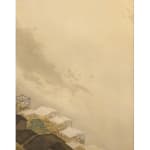Shibata Ban'yō
Enjoying a Cool Evening on Ponto-chō, Kyoto, 1910s-20s
Hanging scroll; ink, mineral pigments and shell powder on silk
Overall size 82 x 20 in. (208 x 51 cm)
Image size 52¼ x 14½ in. (133 x 37 cm)
Image size 52¼ x 14½ in. (133 x 37 cm)
T-4852
Signed at upper right Ban’yō seisaku (Made by Bany’ō) and sealed Naritaka no in (Seal of Naritaka) and Ban’yō Comes with a wood tomobako storage box inscribed outside Ponto-chō; signed...
Signed at upper right Ban’yō seisaku (Made by Bany’ō) and sealed Naritaka no in (Seal of Naritaka) and Ban’yō
Comes with a wood tomobako storage box inscribed outside Ponto-chō; signed inside Ban’yō jidai (Inscribed by Ban’yō) and sealed Ban’yō; paper label Ban’yō Ponto-chō yūsuzumi (Ban’yō: Enjoying a Cool Evening on Ponto-chō)
Adopting his favorite bird’s-eye view perspective, Shibata Ban’yō offers us an atmospheric view of Ponto-chō, Kyoto’s fabled entertainment street, probably on a cool summer evening during the rainy season. The restaurants along the eastern side of the street have built temporary platforms, kawayuka, over the Kamo River, allowing patrons to dine out while enjoying the cooling effect of the flowing water. To the north, pedestrians pass to and fro over the Great Sanjō Bridge, while above the bridge evening mist partially obscures the buildings on the river’s opposite bank. Ban’yō effectively contrasts atmospheric ink washes—characteristic of Kyoto’s Shijō style of painting that takes its name from Shijō Street (as it happens, just to the south of the scene depicted here)—with impressionistic dots of mineral color depicting lively, lantern-lit scenes of restaurant guests and entertainers, while the warm glow emanating from the permanent buildings hints at more exclusive, private events. Comparison of this scroll with other works by the artist shown at the Bunten exhibitions (see below), suggest it likely dates from the earlier part of his career.
Born to a samurai family in Otsu, Shiga Prefecture, Shibata Ban'yō (birth name: Naritaka) graduated in 1908 and 1912 from art school and college in nearby Kyoto and was apprenticed to the well-known landscape painter Yamamoto Shunkyo (1871–1933), later teaching at Yamamoto’s painting academy, the Sanaekai. Ban’yō received a Silver Medal at the 1915 Panama-Pacific International Exposition, became an assistant instructor at Kyoto Municipal School of Arts and Crafts, and showed his work at the Bunten and successive national exhibitions on six occasions from 1912 to 1931, as well as at the Tokyo Taisho exhibition (1914).
Comes with a wood tomobako storage box inscribed outside Ponto-chō; signed inside Ban’yō jidai (Inscribed by Ban’yō) and sealed Ban’yō; paper label Ban’yō Ponto-chō yūsuzumi (Ban’yō: Enjoying a Cool Evening on Ponto-chō)
Adopting his favorite bird’s-eye view perspective, Shibata Ban’yō offers us an atmospheric view of Ponto-chō, Kyoto’s fabled entertainment street, probably on a cool summer evening during the rainy season. The restaurants along the eastern side of the street have built temporary platforms, kawayuka, over the Kamo River, allowing patrons to dine out while enjoying the cooling effect of the flowing water. To the north, pedestrians pass to and fro over the Great Sanjō Bridge, while above the bridge evening mist partially obscures the buildings on the river’s opposite bank. Ban’yō effectively contrasts atmospheric ink washes—characteristic of Kyoto’s Shijō style of painting that takes its name from Shijō Street (as it happens, just to the south of the scene depicted here)—with impressionistic dots of mineral color depicting lively, lantern-lit scenes of restaurant guests and entertainers, while the warm glow emanating from the permanent buildings hints at more exclusive, private events. Comparison of this scroll with other works by the artist shown at the Bunten exhibitions (see below), suggest it likely dates from the earlier part of his career.
Born to a samurai family in Otsu, Shiga Prefecture, Shibata Ban'yō (birth name: Naritaka) graduated in 1908 and 1912 from art school and college in nearby Kyoto and was apprenticed to the well-known landscape painter Yamamoto Shunkyo (1871–1933), later teaching at Yamamoto’s painting academy, the Sanaekai. Ban’yō received a Silver Medal at the 1915 Panama-Pacific International Exposition, became an assistant instructor at Kyoto Municipal School of Arts and Crafts, and showed his work at the Bunten and successive national exhibitions on six occasions from 1912 to 1931, as well as at the Tokyo Taisho exhibition (1914).



